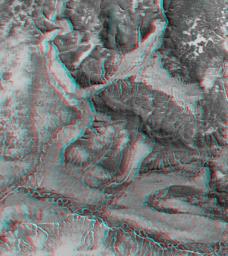This 3-D anaglyph shows an area on the western side of the volcanically active Kamchatka Peninsula, Russia. Red-blue glasses are required to see the 3-D effect. The topographic data are from the first C-band mapping swath of the Shuttle Radar Topography Mission (SRTM). Images from the optical Landsat satellite are overlain on the SRTM topography data. The meandering channel of the Tigil River is seen along the bottom of the image, at the base of steep cliffs. In the middle left of the image, a terrace indicates recent uplift of the terrain and downcutting by the river. High resolution SRTM topographic data will be used by geologists and hydrologists to study the interplay of tectonic uplift and erosion.
This anaglyph was generated using topographic data from the Shuttle Radar Topography Mission to create two differing perspectives of a single image, one perspective for each eye. Each point in the image is shifted slightly, depending on its elevation. When viewed through special glasses, the result is a vertically exaggerated view of the Earth's surface in its full three dimensions. Anaglyph glasses cover the left eye with a red filter and cover the right eye with a blue filter. The United States Geological Survey's Earth Resources Observations Systems (EROS) Data Center, Sioux Falls, South Dakota, provided the Landsat data, which are overlain on the topography.
The Shuttle Radar Topography Mission (SRTM), launched on February 11, 2000, uses the same radar instrument that comprised the Spaceborne Imaging Radar-C/X-Band Synthetic Aperture Radar (SIR-C/X-SAR) that flew twice on the Space Shuttle Endeavour in 1994. The mission is designed to collect three-dimensional measurements of the Earth's surface. To collect the 3-D data, engineers added a 60-meter-long (200-foot) mast, an additional C-band imaging antenna and improved tracking and navigation devices. The mission is a cooperative project between the National Aeronautics and Space Administration (NASA), the National Imagery and Mapping Agency (NIMA) and the German (DLR) and Italian (ASI) space agencies. It is managed by NASA's Jet Propulsion Laboratory, Pasadena, CA, for NASA's Earth Science Enterprise, Washington, DC.
Size: 5.3 km (3.3 miles) x 6.0 km (3.7 miles)
Location: 57 deg. North lat., 159 deg. East lon.
Orientation: North at left
Original Data Resolution: SRTM 30 meters (99 feet); Landsat 15 meters (45 feet)
Date Acquired: February 12, 2000

 Planetary Data System
Planetary Data System












